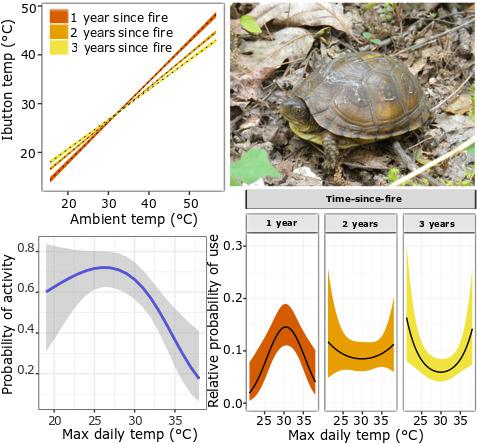当前位置:
X-MOL 学术
›
Glob. Change Biol.
›
论文详情
Our official English website, www.x-mol.net, welcomes your
feedback! (Note: you will need to create a separate account there.)
Fire management alters the thermal landscape and provides multi-scale thermal options for a terrestrial turtle facing a changing climate
Global Change Biology ( IF 10.8 ) Pub Date : 2021-11-06 , DOI: 10.1111/gcb.15977 Ellen P Robertson 1, 2 , Evan P Tanner 3 , R Dwayne Elmore 1 , Samuel D Fuhlendorf 1 , Jonathan D Mays 4 , Jennifer Knutson 1 , John R Weir 1 , Scott R Loss 1
Global Change Biology ( IF 10.8 ) Pub Date : 2021-11-06 , DOI: 10.1111/gcb.15977 Ellen P Robertson 1, 2 , Evan P Tanner 3 , R Dwayne Elmore 1 , Samuel D Fuhlendorf 1 , Jonathan D Mays 4 , Jennifer Knutson 1 , John R Weir 1 , Scott R Loss 1
Affiliation

|
As effects of climate change intensify, there is a growing need to understand the thermal properties of landscapes and their influence on wildlife. A key thermal property of landscapes is vegetation structure and composition. Management approaches can alter vegetation and consequently the thermal landscape, potentially resulting in underappreciated consequences for wildlife thermoregulation. Consideration of spatial scale can clarify how management overlaid onto existing vegetation patterns affects thermal properties of landscapes relevant to wildlife. We examined effects of temperature, fire management, and vegetation structure on multi-scale habitat selection of an ectothermic vertebrate (the turtle Terrapene carolina triunguis) in the Great Plains of the central United States by linking time-since-fire data from 18 experimental burn plots to turtle telemetry locations and thermal and vegetation height data. Within three 60-ha experimental landscapes, each containing six 10-ha sub-blocks that are periodically burned, we found that turtles select time-since-fire gradients differently depending on maximum daily ambient temperature. At moderate temperatures, turtles selected sub-blocks with recent (<1 year) time-since-fire, but during relatively hot and cool conditions, they selected sub-blocks with later (2–3 year) time-since-fire that provided thermal buffering compared with recently burned sub-blocks. Within 10-ha sub-blocks, turtles selected locations with taller vegetation during warmer conditions that provided thermal buffering. Thermal performance curves revealed that turtle activity declined as temperatures exceeded ~24–29°C, and on “heat days” (≥29°C) 73% of turtles were inactive compared with 37% on non-heat days, emphasizing that thermal extremes may lead to opportunity costs (i.e., foregone benefits turtles could otherwise accrue if active). Our results indicate that management approaches that promote a mosaic of vegetation heights, like spatiotemporally dynamic fire, can provide thermal refuges at multiple spatial scales and thus be an actionable way to provide wildlife with multiple thermal options in the context of ongoing and future climate change.
中文翻译:

火灾管理改变了热景观,并为面临气候变化的陆龟提供了多尺度的热选择
随着气候变化影响的加剧,越来越需要了解景观的热特性及其对野生动物的影响。景观的一个关键热特性是植被结构和组成。管理方法可以改变植被,从而改变热景观,可能导致野生动物体温调节的后果被低估。考虑空间尺度可以阐明覆盖在现有植被模式上的管理如何影响与野生动物相关的景观的热特性。我们研究了温度、火灾管理和植被结构对变温脊椎动物(乌龟Terrapene carolina triunguis )多尺度栖息地选择的影响。) 在美国中部的大平原,通过将来自 18 个实验燃烧地块的火灾时间数据与海龟遥测位置以及热量和植被高度数据联系起来。在三个 60 公顷的实验景观中,每个包含六个定期燃烧的 10 公顷的子块,我们发现海龟根据最高每日环境温度选择不同的火灾后梯度。在中等温度下,海龟选择最近(<1 年)起火时间的子块,但在相对炎热和凉爽的条件下,它们选择具有较晚(2-3 年)火灾时间的子块与最近烧毁的子块相比的热缓冲。在 10 公顷的子区块内,海龟会在较温暖的条件下选择植被较高的位置,以提供热缓冲。热性能曲线显示,当温度超过约 24–29°C 时,海龟活动会下降,在“高温日”(≥29°C),73% 的海龟不活动,而在非高温日为 37%,强调极端高温可能会导致机会成本(即,如果海龟活跃,则放弃的好处可能会累积)。我们的结果表明,促进植被高度镶嵌的管理方法,如时空动态火灾,可以在多个空间尺度上提供热避难所,因此是在当前和未来气候变化的背景下为野生动物提供多种热选择的可行方式。强调极端温度可能会导致机会成本(即,如果海龟活跃,则可能会产生已放弃的收益)。我们的结果表明,促进植被高度镶嵌的管理方法,如时空动态火灾,可以在多个空间尺度上提供热避难所,因此是在当前和未来气候变化的背景下为野生动物提供多种热选择的可行方式。强调极端温度可能会导致机会成本(即,如果海龟活跃,则可能会产生已放弃的收益)。我们的结果表明,促进植被高度镶嵌的管理方法,如时空动态火灾,可以在多个空间尺度上提供热避难所,因此是在当前和未来气候变化的背景下为野生动物提供多种热选择的可行方式。
更新日期:2022-01-05
中文翻译:

火灾管理改变了热景观,并为面临气候变化的陆龟提供了多尺度的热选择
随着气候变化影响的加剧,越来越需要了解景观的热特性及其对野生动物的影响。景观的一个关键热特性是植被结构和组成。管理方法可以改变植被,从而改变热景观,可能导致野生动物体温调节的后果被低估。考虑空间尺度可以阐明覆盖在现有植被模式上的管理如何影响与野生动物相关的景观的热特性。我们研究了温度、火灾管理和植被结构对变温脊椎动物(乌龟Terrapene carolina triunguis )多尺度栖息地选择的影响。) 在美国中部的大平原,通过将来自 18 个实验燃烧地块的火灾时间数据与海龟遥测位置以及热量和植被高度数据联系起来。在三个 60 公顷的实验景观中,每个包含六个定期燃烧的 10 公顷的子块,我们发现海龟根据最高每日环境温度选择不同的火灾后梯度。在中等温度下,海龟选择最近(<1 年)起火时间的子块,但在相对炎热和凉爽的条件下,它们选择具有较晚(2-3 年)火灾时间的子块与最近烧毁的子块相比的热缓冲。在 10 公顷的子区块内,海龟会在较温暖的条件下选择植被较高的位置,以提供热缓冲。热性能曲线显示,当温度超过约 24–29°C 时,海龟活动会下降,在“高温日”(≥29°C),73% 的海龟不活动,而在非高温日为 37%,强调极端高温可能会导致机会成本(即,如果海龟活跃,则放弃的好处可能会累积)。我们的结果表明,促进植被高度镶嵌的管理方法,如时空动态火灾,可以在多个空间尺度上提供热避难所,因此是在当前和未来气候变化的背景下为野生动物提供多种热选择的可行方式。强调极端温度可能会导致机会成本(即,如果海龟活跃,则可能会产生已放弃的收益)。我们的结果表明,促进植被高度镶嵌的管理方法,如时空动态火灾,可以在多个空间尺度上提供热避难所,因此是在当前和未来气候变化的背景下为野生动物提供多种热选择的可行方式。强调极端温度可能会导致机会成本(即,如果海龟活跃,则可能会产生已放弃的收益)。我们的结果表明,促进植被高度镶嵌的管理方法,如时空动态火灾,可以在多个空间尺度上提供热避难所,因此是在当前和未来气候变化的背景下为野生动物提供多种热选择的可行方式。











































 京公网安备 11010802027423号
京公网安备 11010802027423号